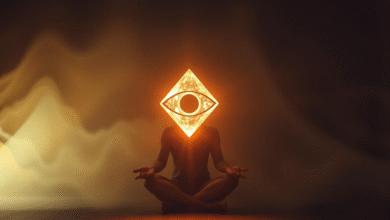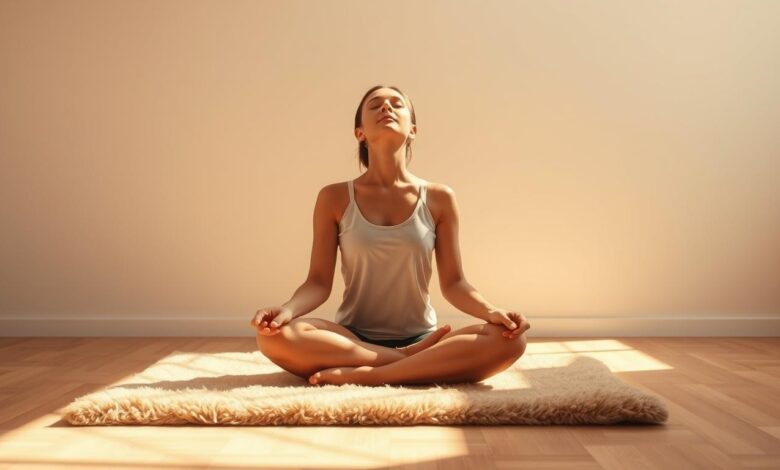
Enhance Mindfulness and Awareness with Yoga Nidra
Yoga Nidra offers a powerful way to deepen mindfulness and awareness through guided meditation. This ancient practice combines breathwork and mental focus to create a state of conscious relaxation. Whether you’re new to meditation or seeking to refine your routine, yoga nidra for mindfulness and awareness provides accessible tools to calm the mind and connect with the present moment.
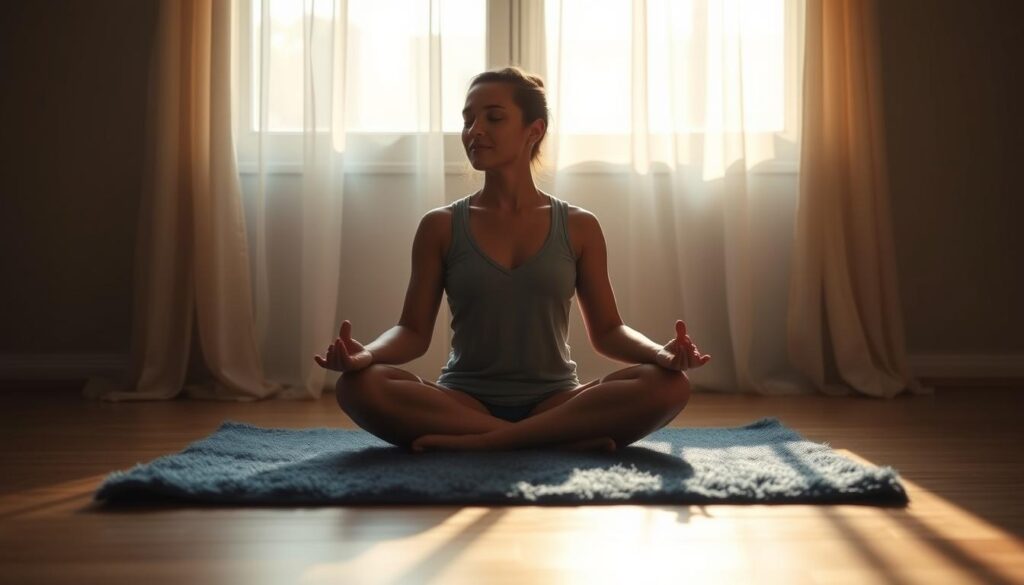
Rooted in tradition yet adaptable for modern life, yoga nidra uses structured sessions to guide practitioners into a state between waking and sleeping. This unique approach makes it easier to observe thoughts without judgment, fostering clarity and emotional balance. By prioritizing mental stillness, it becomes a bridge between physical relaxation and heightened self-awareness.
Key Takeaways
- Yoga nidra combines guided meditation with relaxation to boost mindfulness.
- It requires no special skills, making it ideal for beginners and experienced practitioners.
- Regular practice improves focus and emotional resilience through conscious awareness.
- Guided sessions help reduce stress and enhance sleep quality naturally.
- Accessible techniques create lasting mental and emotional benefits.
What is Yoga Nidra?
Yoga Nidra is a deep relaxation practice rooted in ancient yogic traditions. Unlike regular sleep, it’s a conscious relaxation method that guides practitioners into a state of heightened awareness while the body rests. Originating from texts like the Mandukya Upanishad, it gained modern popularity through 20th-century yogis like Swami Satyananda Saraswati.
Definition and Origins
This practice blends meditation and sleep, fostering mental clarity while the body rests. Its roots trace back thousands of years, with contemporary methods now accessible worldwide through guided sessions and apps like Insight Timer or Headspace.
Benefits of Yoga Nidra
- Reduces stress and anxiety through mindful body scanning
- Improves sleep quality by calming the nervous system
- Enhances focus and emotional balance via guided imagery
Studies show this deep relaxation practice lowers cortisol levels, making it a science-backed tool for modern wellness.
Popular Practices
Core methods include:
- Satyananda Style: Uses systematic body awareness and breath focus
- iRest® (Integrative Restoration): Combines yoga philosophy with modern psychology
- Modern Adaptations: Online platforms offer 10–20 minute sessions for busy lifestyles
Whether in a class or at home, this conscious relaxation method adapts to anyone’s schedule, proving that even brief sessions yield long-term mental and physical benefits.
Understanding Mindfulness and Awareness
At its core, mindfulness is the art of noticing the present without judgment. This skill forms the foundation for practices like yoga nidra, helping individuals connect with their inner world. Let’s break down how these concepts shape daily life.
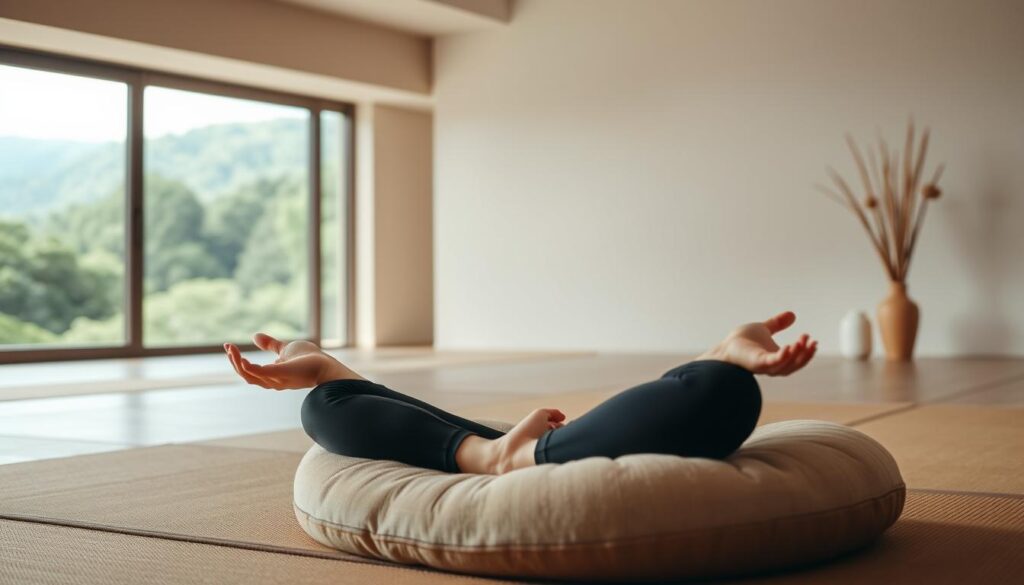
The Importance of Mindfulness
Practicing mindfulness sharpens improve self-awareness by guiding attention to breath, sensations, and emotions. This simple act reduces stress and boosts emotional resilience. Key benefits include:
- Quieting overthinking patterns
- Enhancing focus during tasks
- Building patience in challenging situations
The Role of Awareness in Daily Life
Awareness transforms routine actions into mindful moments. For example:
“Awareness is the lens through which we view our experiences.”
| Area of Life | With Awareness | Without Awareness |
|---|---|---|
| Eating | Savoring flavors and fullness cues | Mindless snacking |
| Communication | Listening fully to others | Tuning out during conversations |
Combining these elements turns ordinary activities into opportunities for growth. By integrating mindfulness practice for relaxation into routines, individuals foster clarity and balance naturally.
How Yoga Nidra Promotes Mindfulness
Yoga nidra for mindfulness and awareness begins by guiding the mind into a state of deep relaxation. This practice blends physical stillness with mental focus, helping individuals stay present during moments of rest. As you lie comfortably, guided sessions teach you to notice body sensations and thoughts without judgment. Over time, this builds a stronger connection to the present, reducing mental clutter and fostering clarity.
Deep Relaxation Techniques
- Body scans: Moving awareness through each body part encourages focus on the here and now.
- Breath observation: Tracking the natural rhythm of breathing trains the mind to stay anchored in the present.
- Thought witnessing: Observing thoughts as they arise without attachment strengthens non-judgmental awareness.
Connection Between Mindfulness and Sleep
Yoga nidra works with the brain’s sleep cycles while keeping consciousness alert. This unique state activates the parasympathetic nervous system, a key stress relief technique. Better sleep quality from regular practice improves mindfulness by reducing mental fatigue. When the mind rests deeply, it becomes easier to approach daily tasks with calm focus.
The Science Behind Yoga Nidra
Modern research reveals how yoga nidra alters brain function to enhance mental clarity through yoga nidra and promote inner peace. Studies show this practice triggers measurable changes in brainwave patterns and neural pathways.

Physiological Effects on the Brain
During yoga nidra, the brain shifts into slower theta and alpha wave states, similar to deep meditation. This shift activates the parasympathetic nervous system, reducing stress hormones like cortisol. Neuroimaging shows increased activity in the prefrontal cortex—the brain’s “decision-making” center—and reduced reactivity in the amygdala, which processes fear.
Research Findings on Mindfulness
- A 2020 study in the Journal of Bodywork and Movement Therapies found yoga nidra increased gray matter density in brain regions linked to emotional regulation.
- Harvard researchers observed a 35% average improvement in mindfulness scores among participants practicing twice weekly.
A single session of yoga nidra can reset the brain’s default mode network, fostering mental clarity and emotional balance.” — Dr. Emily Carter, Neuroscientist at Stanford University
Neuroplasticity research confirms long-term practice strengthens neural connections supporting focus and calmness. These findings explain why healthcare providers increasingly recommend yoga nidra for stress-related conditions.
Steps to Practice Yoga Nidra
Mastering yoga nidra starts with understanding its structure. This conscious relaxation method requires minimal setup but maximum focus. Follow these actionable steps to begin your journey today.
Preparing for Your Session
Create a sanctuary for your practice. Use these tips to optimize your environment:
- Choose a quiet space with soft lighting and a comfortable surface like a yoga mat or blanket.
- Layer blankets or use an eye pillow to block out light and enhance comfort.
- Practice on an empty stomach, ideally 1-2 hours after eating.
- Set a personal intention (sankalpa) like “I am calm” to anchor your session.
The Guided Relaxation Process
Follow this sequence during your guided meditation session:
- Lie on your back, arms relaxed, and close your eyes.
- Breathe deeply, releasing tension with each exhale.
- Scan your body mentally, relaxing each area from toes to scalp.
- Visualize a serene scene, such as a forest or beach, to deepen focus.
- Awaken slowly, staying mindful of your renewed energy.
Every practice is unique—there’s no “wrong way” to experience this method. Whether you drift into light sleep or stay alert, the conscious relaxation method adapts to your needs. Practice daily to build resilience against stress and improve focus. Start small, even 10 minutes daily, to see results over time.
Incorporating Yoga Nidra into Daily Life
Turning yoga nidra into a daily ritual starts with small, intentional choices. Here’s how to make deep relaxation practice a natural part of your routine.

Tips for Consistent Practice
- Set a fixed time: Choose a daily window—like morning or evening—to anchor your routine.
- Start small: Begin with 10–15 minute sessions, expanding as comfort grows.
- Use reminders: Schedule alerts on your phone or calendar to avoid missing sessions.
- Track progress: Note reflections in a journal to observe self-discovery with yoga nidra insights over time.
Setting Up a Dedicated Space
A consistent environment primes the mind for practice. Create a corner with these essentials:
| Item | Purpose |
|---|---|
| Yoga mat | Physical boundary for focus |
| Soft lighting | Mood enhancement for calmness |
| Cushioned bolster | Support for comfortable positioning |
Even temporary spaces, like a cozy chair or corner, work if consistency is prioritized over perfection.
Yoga Nidra Techniques for Beginners
Begin your journey with yoga nidra through guided meditation or a simple mindfulness practice for relaxation. These techniques are designed for newcomers, making it easy to explore this transformative practice.

Basic Techniques to Get Started
Try these steps to build a foundation:
- Find a quiet space and lie on your back. Close your eyes gently.
- Use a guided meditation app or follow a 10-minute script like this:
“Bring awareness to your toes… Notice sensations in your feet… Breathe deeply into your belly…”
3. Focus on breath rhythm to stay present. Let thoughts pass like clouds in the sky.
Common Mistakes to Avoid
| Mistake | Solution |
|---|---|
| Falling asleep | Set a gentle timer and use seated postures instead of lying down. |
| Overthinking | Redirect focus to the mindfulness practice for relaxation—like counting breaths. |
| Impatience | Track progress weekly in a journal to see gradual improvements. |
Progress comes with practice. Celebrate small wins and adjust techniques as needed.
Advanced Yoga Nidra Practices
As you deepen your practice, advanced yoga nidra opens new pathways to improve self-awareness and sharpen mental clarity through yoga nidra. These techniques invite practitioners to explore subtler layers of consciousness, fostering profound personal transformation.
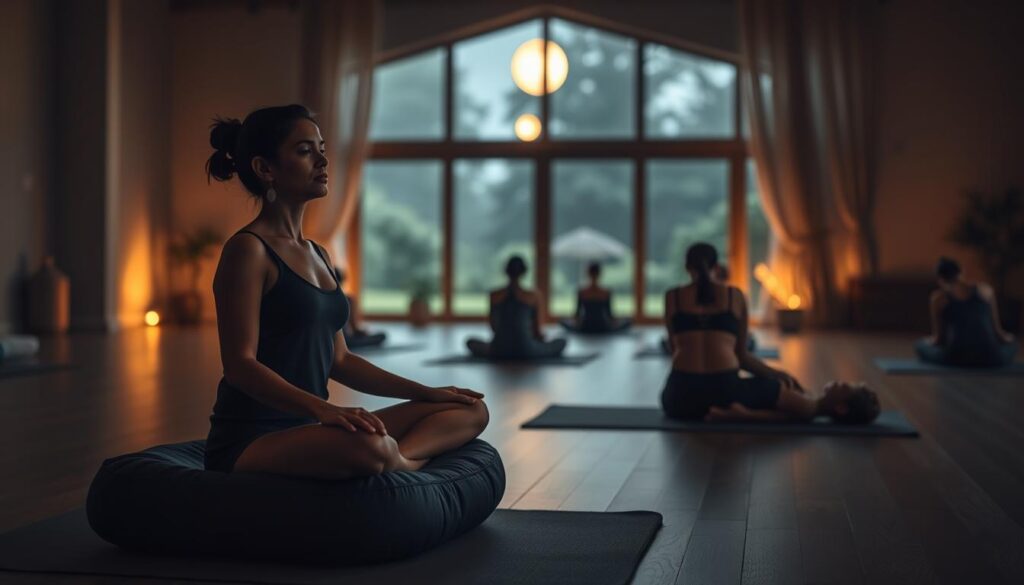
Expanding Awareness Through Advanced Methods
Experienced yogis can refine their practice with specialized approaches:
- Extended consciousness rotations: Trace energy flow beyond the physical body, noting sensations in etheric or emotional layers.
- Sensory contrasts: Focus on opposing physical sensations (e.g., warmth vs. coolness) to heighten sensory discrimination.
- Duration expansion: Gradually lengthen sessions from 20 to 40+ minutes to sustain deeper states of awareness.
Visualization Mastery for Inner Exploration
Visualization becomes a powerful tool when combined with yoga nidra’s receptive state:
- Chakra journeys: Mentally “visit” each energy center to identify blockages and emotional patterns.
- Archetypal imagery: Engage with symbolic figures (e.g., inner guide, ancestral voices) to uncover subconscious themes.
- Custom healing scenes: Create personalized imagery addressing current life challenges for targeted insights.
These practices gently unveil hidden mental patterns, fostering the kind of self-awareness that translates into clearer decision-making and emotional balance. Consistency in these methods reveals how yoga nidra’s advanced layers can become a lifelong guide for inner exploration.
Using Yoga Nidra for Stress Relief
Modern life often feels overwhelming, but yoga nidra offers a proven stress relief technique to calm the mind and promote inner peace. This practice guides the body into deep relaxation, counteracting the physical toll of daily pressures.
Impact of Stress on the Body

Chronic stress triggers the release of cortisol, a hormone linked to anxiety and fatigue. Over time, this can disrupt sleep, weaken immunity, and strain relationships. Common symptoms include tight muscles, racing thoughts, and difficulty focusing.
- Increased heart rate and blood pressure
- Weakened immune response
- Emotional overwhelm
How Yoga Nidra Alleviates Stress
During yoga nidra, the body enters a state of conscious relaxation, activating the parasympathetic nervous system. This process:
- Reduces cortisol levels through guided breathing and visualization
- Encourages mental stillness by focusing awareness away from stressors
- Strengthens emotional resilience over time
“After regular practice, I stopped feeling overwhelmed by deadlines. Yoga nidra taught me to stay calm even during chaos.” — David, software developer
By integrating this practice, individuals build a sustainable stress relief technique. Over weeks, participants often report improved sleep, clearer thinking, and a renewed sense of balance. This approach doesn’t just address symptoms—it fosters lasting inner peace by rewiring the brain’s stress responses.
Yoga Nidra and Emotional Balance
Yoga nidra unlocks emotional clarity through self-discovery with yoga nidra, guiding you to observe feelings without judgment. This practice helps promote inner peace by creating space between emotions and reactions, fostering resilience.

Cultivating Emotional Awareness
During yoga nidra, you learn to witness emotions as passing sensations. This self-discovery with yoga nidra process reveals patterns like recurring anger or anxiety triggers. By labeling emotions without attachment, you gain control over automatic responses.
Tools for Navigating Difficult Emotions
- Body scans: Notice where emotions physically manifest—tension in the shoulders or tightness in the chest.
- Breath focus: Slow, rhythmic breathing calms the nervous system during emotional storms.
- Mantras: Repeat phrases like “This feeling is temporary” to reframe perspectives.
Practicing these steps regularly sharpens emotional literacy, leading to healthier relationships and decision-making. Every session is a step toward lasting promote inner peace.
Conclusion: Embracing Mindfulness through Yoga Nidra
Yoga Nidra offers a pathway to deeper self-awareness and calm. By integrating this practice, individuals can experience lasting improvements in mental and emotional well-being. This article has explored how yoga nidra for mindfulness and awareness transforms daily life through structured relaxation and focused attention.
The Long-Term Benefits of Regular Practice
Regular sessions build resilience against stress and enhance sleep quality. Over time, practitioners report sharper focus and emotional balance, showing how this practice becomes a cornerstone of holistic health. Sustained yoga nidra strengthens the mind-body connection, fostering clarity that extends beyond the practice itself.
Encouragement to Begin Your Journey
Starting small is key. Explore guided sessions on apps like Insight Timer or Calm. Mindfulness practice for relaxation doesn’t require perfection—just a few minutes daily. Whether new or experienced, every session brings progress. The journey begins with the first step, so why not start today?
FAQ
What is Yoga Nidra and how does it work?
Yoga Nidra is a systematic form of guided meditation often referred to as “yogic sleep.” It allows you to reach deep states of relaxation while maintaining conscious awareness. During each session, practitioners follow a guided process that encourages body awareness, breath observation, and visualization techniques, promoting mindfulness and a deep sense of peace.
How can Yoga Nidra help with stress relief?
Yoga Nidra serves as an effective stress relief technique by reducing physiological stress responses. It activates the parasympathetic nervous system, which helps to lower cortisol levels, improve sleep quality, and enhance emotional regulation. This conscious relaxation method can help you feel more balanced and centered, making it easier to manage stress in daily life.
Is Yoga Nidra suitable for beginners?
Absolutely! Yoga Nidra is highly accessible and can be practiced by individuals of all experience levels. Whether you are new to meditation or have prior experience, the guided nature of Yoga Nidra ensures that you can follow along easily. It is an excellent introduction to mindfulness practices, allowing you to explore self-awareness and relaxation without the need for complicated techniques.
How often should I practice Yoga Nidra to see benefits?
For optimal benefits, it is recommended to practice Yoga Nidra regularly. Even short sessions, like 10-20 minutes a few times a week, can lead to improvements in mindfulness, mental clarity, and emotional well-being over time. The key is consistency, allowing you to experience the cumulative effects of this practice.
Can Yoga Nidra improve my sleep?
Yes! Many practitioners find that Yoga Nidra significantly improves their sleep quality. By engaging in this deep relaxation practice, you can calm your mind, release tension from your body, and prepare for a restful night’s sleep. The techniques used in Yoga Nidra have been shown to support better sleep patterns and alleviate insomnia.
What should I do if I find myself falling asleep during Yoga Nidra?
Falling asleep during Yoga Nidra is a common experience, especially when the body is in a deeply relaxed state. If this happens, try adjusting your posture to a position that is less likely to induce sleep, like lying on your back with your knees bent. Alternatively, practice Yoga Nidra at a time when you are less tired to help maintain awareness while still enjoying the deep relaxation benefits.
How does Yoga Nidra promote self-awareness?
Yoga Nidra fosters self-awareness by guiding practitioners to observe their thoughts, emotions, and sensations without attachment or judgment. This practice of conscious observation helps deepen your understanding of your internal experiences, leading to greater emotional intelligence and insight into habitual patterns of behavior.

